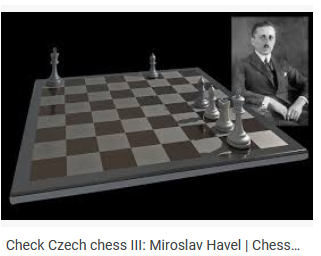 Four helpmates to recovery, two of which are long and I consider quite difficult; but rather attractive. Three problems in homage to an unexpected railwayman: wasn't Havel his country's minister of transport? His 4# is certainly the easiest of the three (and one of the few easy 4# by this author). Another 4# of the "logical" kind, then a very simple and very pleasant 7#. Finally, a superb selfmate 4# by the Austrian grandmaster.
Four helpmates to recovery, two of which are long and I consider quite difficult; but rather attractive. Three problems in homage to an unexpected railwayman: wasn't Havel his country's minister of transport? His 4# is certainly the easiest of the three (and one of the few easy 4# by this author). Another 4# of the "logical" kind, then a very simple and very pleasant 7#. Finally, a superb selfmate 4# by the Austrian grandmaster.

An equestrian warm-up as an appetizer. Its key contradicts a fundamental principle of endgames: "when you have the material advantage, exchange pieces, not pawns". A position evoked in the essay 1 Nd1? (Kc7, Nb6, Pd6 / Ke6, Ne5) turns out to be a draw, even for Black: 1...Kf7! (Kf5! also) 2 Nc4 Nd3! 3 d7 Nc5 or 2...Ng6! 3 d7 Nf8! Like what, if N+P/N wins in general with the pawn in 7th, it is always necessary to be wary when it is only in 6th.
Then a fantastic repetitive manoeuvre of the great Pervakov. The correction of this study is a miracle, the refutations of the false leads, as well as the continuations on the lower defences, must be distinct, because if the key-scheme is found in equipollent positions, the black pawns of the kingside have not moved! Here again, we had the opportunity to unearth an interesting position, which will perhaps even be the subject of an article: in Kb5, Qg3 / Ke3, Rc2, Pg2, Black holds the draw, but just barely (1...Ke4!). As for Q / R+Pc6, the wK must not go to b4 but stay on the "e" file, then go up, while the bP also goes up: paradoxically the more the Black pawn advances, the closer White's win is (see Halberstadt & Chéron).


Curious game of the day. A position that promises to be flat comes to dizzying life, until Black misses the good defence that... would have restored the flatness. And, as an aside to the last comment, Kramnik's rescue in the Queen's endgame.
Enough to get you over the new railway aggression. Obviously, the saboteurs consult the course calendar before triggering the paralysis. But they are wrong. The listeners are not lemmings.
See you next Tuesday, 30 March.
Have a good lunch
AV
Add a comment